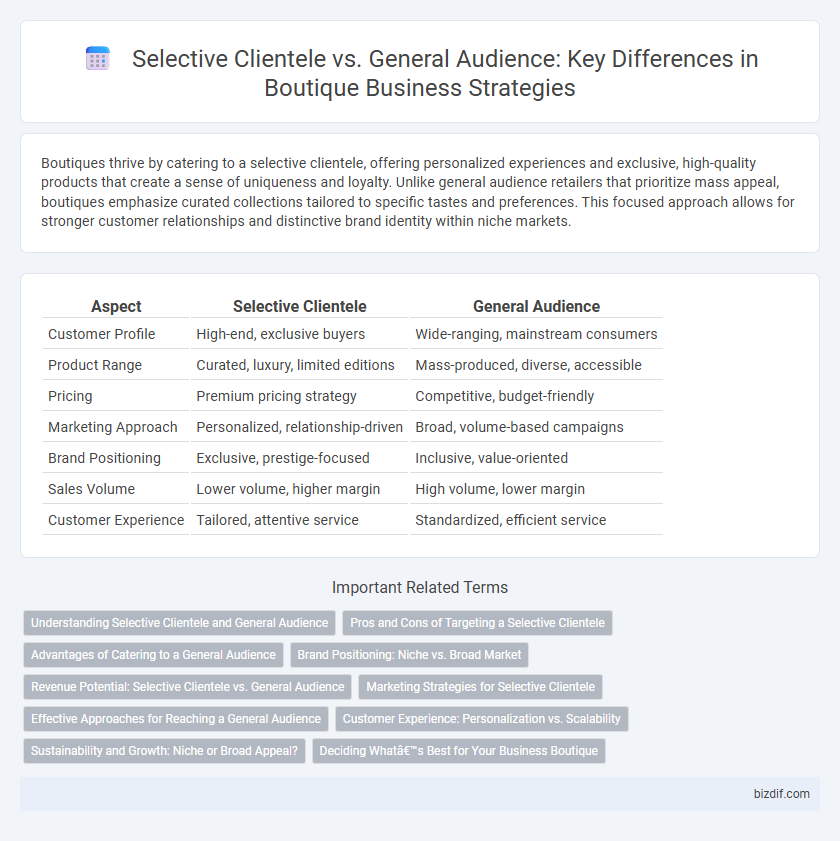Boutiques thrive by catering to a selective clientele, offering personalized experiences and exclusive, high-quality products that create a sense of uniqueness and loyalty. Unlike general audience retailers that prioritize mass appeal, boutiques emphasize curated collections tailored to specific tastes and preferences. This focused approach allows for stronger customer relationships and distinctive brand identity within niche markets.
Table of Comparison
| Aspect | Selective Clientele | General Audience |
|---|---|---|
| Customer Profile | High-end, exclusive buyers | Wide-ranging, mainstream consumers |
| Product Range | Curated, luxury, limited editions | Mass-produced, diverse, accessible |
| Pricing | Premium pricing strategy | Competitive, budget-friendly |
| Marketing Approach | Personalized, relationship-driven | Broad, volume-based campaigns |
| Brand Positioning | Exclusive, prestige-focused | Inclusive, value-oriented |
| Sales Volume | Lower volume, higher margin | High volume, lower margin |
| Customer Experience | Tailored, attentive service | Standardized, efficient service |
Understanding Selective Clientele and General Audience
Selective clientele refers to a specific group of clients characterized by distinct preferences, higher purchasing power, and a demand for exclusive, personalized experiences often associated with luxury or niche products. In contrast, a general audience encompasses a broad, diverse group with varied needs and price sensitivities, typically targeted by mass-market retailers aiming for widespread appeal. Understanding these differences allows boutiques to tailor their marketing strategies and product offerings to enhance customer satisfaction and brand loyalty effectively.
Pros and Cons of Targeting a Selective Clientele
Targeting a selective clientele in a boutique setting enhances brand exclusivity and allows for personalized services that foster customer loyalty and higher profit margins. Narrowing focus to a defined group, however, limits market reach and may slow revenue growth compared to serving a general audience. The strategy demands deeper customer insights and consistent quality to successfully maintain brand prestige and customer satisfaction.
Advantages of Catering to a General Audience
Catering to a general audience allows boutiques to expand market reach and increase potential revenue streams through higher foot traffic and diverse customer demographics. Offering a broad range of products and styles enhances brand visibility and attracts varied consumer preferences, fostering brand loyalty across multiple segments. This approach also facilitates scalable marketing strategies and partnerships, maximizing growth opportunities in competitive retail environments.
Brand Positioning: Niche vs. Broad Market
Boutique brands targeting a selective clientele emphasize exclusivity and personalized experiences, strengthening their niche market positioning by catering to specific tastes and high-value customers. This focused approach enhances brand loyalty and perceived value, distinguishing boutique brands from those addressing a broad market. In contrast, general audience brands prioritize mass appeal and accessibility, often sacrificing exclusivity to capture larger market shares.
Revenue Potential: Selective Clientele vs. General Audience
Targeting a selective clientele in a boutique setting maximizes revenue potential by focusing on high-margin, exclusive products that cater to specific tastes and increase customer loyalty. In contrast, serving a general audience often leads to higher sales volume but lower profit margins due to broader product diversification and competitive pricing. Revenue from selective clients tends to be more stable and profitable, driven by personalized services and premium pricing strategies.
Marketing Strategies for Selective Clientele
Marketing strategies for a selective clientele emphasize personalized experiences, exclusive offers, and tailored communications that resonate with niche preferences and high-value customers. Boutique brands leverage targeted social media campaigns, luxury collaborations, and curated content to build strong emotional connections and brand loyalty. Precision in audience segmentation and data analytics allows for optimized resource allocation, maximizing engagement and conversion rates within the selective client base.
Effective Approaches for Reaching a General Audience
Boutiques targeting a general audience often employ broad-reaching marketing strategies such as social media advertising, influencer partnerships, and inclusive product lines to maximize visibility. Utilizing data analytics enables these businesses to identify trending consumer preferences and tailor campaigns that resonate with diverse demographics. Emphasizing exceptional customer service and community engagement further strengthens brand loyalty across varied customer segments.
Customer Experience: Personalization vs. Scalability
Boutique businesses excel in creating personalized customer experiences through selective clientele, allowing tailored services that enhance satisfaction and loyalty. This approach fosters deep connections but limits scalability compared to targeting a general audience. General audience strategies prioritize broad reach and operational efficiency, sacrificing personalization for volume and standardized service delivery.
Sustainability and Growth: Niche or Broad Appeal?
Selective clientele in boutiques fosters sustainability by cultivating strong brand loyalty and personalized experiences, driving consistent growth within a targeted market segment. Catering to a niche audience enables precise inventory management and reduces environmental impact through limited overproduction. Broad appeal strategies may increase revenue but often sacrifice sustainability due to higher waste and diluted brand identity.
Deciding What’s Best for Your Business Boutique
Choosing between targeting a selective clientele or a general audience significantly impacts a boutique's brand identity and profitability. A selective clientele strategy emphasizes personalized service, exclusive offerings, and higher profit margins, attracting customers seeking unique and curated experiences. In contrast, appealing to a general audience requires broader product ranges and competitive pricing but can scale revenue through higher volume and brand exposure.
Selective Clientele vs General Audience Infographic

 bizdif.com
bizdif.com